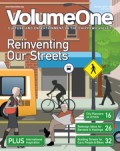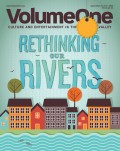Get out there & do it: PRIDE IN PLACE
WORDS Jay Walljasper, from The Great Neighborhood Book
How to nurture what your neighborhood has, hold onto it, and move forward
BECOME A NEIGHBORHOOD PATRIOT
Fred Kent, president of the Project for Public Spaces, a placemaking advocacy nonprofit, sings the praises of what he calls “zealous nuts” at every opportunity. That’s his term for the local heroes who make things happen in communities. These are the folks responsible for the turnaround seen in so many cities in recent years, much more than the politicians, planners, or designers who often claim credit.
“There is hesitation to empower people who seem to care a little too much,” Kent notes, “and who may have minimal experience in planning, business, or government. But zealous nuts know more about the places they live and work than anyone else, and therefore their ideas turn out to be the most practical and valuable.”
“Community Patriot” is another way to describe zealous nuts. Sam Adams, Thomas Paine, Paul Revere, and Thomas Jefferson stood up for the places they love in the face of powerful outside forces. You can do the same in your own community by not staying silent when a crisis, an injustice, or a wonderful opportunity arises. Get involved. Talk to your neighbors. Circulate a petition. Write a letter to the editor. Create a flyer and tie it to every doorknob in the neighborhood. Start a website. And most of all, stick with it. The more determined you are and the more people organize who feel the same way, the harder it will be for public officials and other powerbrokers to keep telling you “no.”
DRAW ATTENTION TO WHAT’S SPECIAL ABOUT WHERE YOU LIVE
“There is no there there.”
This criticism, first voiced by writer Gertrude Stein about her hometown of Oakland, California, is about the worst thing you can say about a place. Stein fled Oakland for Paris, never looking back, but her damning words have been repeated millions of times to dismiss seemingly dull cities, towns, and suburbs everywhere.
Stein was dead wrong. Every place has something to offer. But if you don’t make an effort to show it off, you can’t blame people even those who live there, for thinking there is nothing of interest in your neighborhood.
Your neighborhood’s claim to fame may be expansive or more modest, but no less important in defining the soul of the community. And as a neighborhood, you might decide to create something brand new to express your community spirit.
FOCUS AND BUILD ON WHAT’S GOOD TO MAKE THINGS BETTER
The biggest problem in many neighborhoods — especially low-income ones — is caused by perception more than reality. A part of town gets a bad reputation for being “bad,” “tough,” or “declining,” and that reputation is constantly reinforced in the media and local gossip.
Many well-intentioned efforts to help these afflicted areas wind up stigmatizing the community even more. They focus on everything that’s wrong: bad schools, bad crime, bad housing, bad kids, and bad economic opportunities.
Yet even in the most economically and socially challenged communities, there are a lot of good things going on that can be used as the building blocks to make improvements and will slowly become the focus of a neighborhood’s reputation. So focus up on the good stuff and build up from there.
DON’T BE LAZY; HAVE SOME FUN
The task of improving your neighborhood often feels overwhelming. What needs to be done? How do you do it? Where do you start? Many seasoned activists agree that the best way to get things going is to play around. When a community project is enjoyable and entertaining, it stands a much better chance of being successful.
Having a good time is not just an afterthought. Planning some fun as part of every meeting or event is a winning strategy. After a visioning session, clear chairs and tables for a dance party. Rendezvous for dessert at someone’s house when a public hearing is over. Celebrate progress toward your goals with a homemade parade or ice cream social.
DO NOTHING AND ENJOY WHAT’S THERE
“I arise in the morning torn between a desire to improve (or save) the world and a desire to enjoy (or savor) the world,” wrote the great American essayist E.B. White. “This makes it hard to plan the day.”
Ah, that’s the dilemma. You live in a nice place. But it could be nicer — if only the park were fixed up of the traffic slowed down, if the schools were better or the business district brighter. So what to do first? You’d like to plop down on a bench for a while, soak up the sunshine, listen to the birds sing and the kids play, or just watch the world go by. But you really ought to be organizing a meeting, handing out flyers, and enlisting volunteers for the big fundraiser.
Actually, it’s important to do both. Without taking the time to truly savor your neighborhood, you lose touch with why you love it in the first place. Soon, all you see is what’s wrong. And that quickly diminishes your effectiveness as a community advocate. No one is inspired by harried, humorless leaders who would really rather be doing something else.
On a strategic as well as personal level, it’s smart to take a long stroll every evening, linger at the sidewalk café, stop for a chat with neighbors, and just generally revel in all the great things your community offers. Otherwise, what’s the point of living there?


